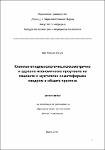I hereby declare that I will use the electronic library contents in compliance with COPYRIGHT AND RELATED RIGHTS ACT, Article 24, paragraph 1, item 9, only for scientific, cultural and educational purposes, without commercial gain, without commercial interest and non-profit.No Yes
Clinical, Epidemiological, Psychometric and Economic Research of Patients with Multiple Somatoform Syndrome in General Medical Practice // Клинико-епидемиологично, психометрично и здравно-икономическо проучване на пациенти с мултиплен соматоформен синдром в общата практика
Abstract
Пациентите бях набрани чрез скрининг в 13 ОПЛ практики(6 градски и 7 селски) с 15 100 записани пациента в област Плевен. Бяха раздадени 816 теста, 608 бяха върнати попълнени и обработени.За верификация на диагнозата използвахме Скрининг за Соматоформни симптоми,след което беше проведено полуструктурирано интервю базирано върху МКБ-10. Диагнозата Мултиплен Соматоформен Синдром беше поставена при наличие най-малко на 3(при жени) и 5 (при мъже) с необясними телесни симптоми в продължение на 6 месеца прехождащи интервюто.По този начин се формираха две групи: една от 126 пациента с МСС и контрола от 142 несоматизиращи.Двегте групи бяха тествани със Скала за Соматосензорна Амплификация,Торонто Алекситимия Скала-20, Скала за Абнормно поведение при боледуване.Здравно икономическите променливи изследвахме използвайки медицинските досиета на пациентите. Оказа се, че нивата на соматизация се увеличават с напредване на възрастта,при наличие на телесна болест.Соматизиращите показаха ясно изразена тенденция за соматосензорна амплификация. Всички тестувани аспекти на абнормното поведение при боледуване са значимо по-ясно изразени при соматизиращи,отколкото при контролите. Абнормното поведение корелира статистически значимо с величината на изразходвания здравен ресурс. Patients were recruited through screening in 13 general practices (6 urban and 7 rural) with a total of 15,100 registered citizens from the district of Pleven. 816 tests were distributed, 608 of which were completed and processed. Screening for Somatoform Symptoms was used for disease verification. After specifying the main sociodemographic characteristics, a semi-structured clinical interview based on ICD-10 was conducted. The diagnosis of Multiple Somatoform Syndrome (MSS) was affixed in cases of at least three (female) and five (male) patients with somatic symptoms unexplained by physical illness, and with continuous manifestation for six months preceding the survey. Two groups were outlined thereafter: target group of 126 patients with MSS, and a control group of 142 patients with similar nonsomatizing demographics. Both groups were tested with Somatosensory Amplification Scale, Toronto Alexithymia Scale-20, and Scale for Assessment of Abnormal Illness Behavior. For health and economic indices research patients’ medical records were used. The picture outlined by these results shows that the level of somatization increases with age, and in the presence of actual physical illness. Somatizing patients show clear tendency to somatosensory amplification. All tested aspects of abnormal illness behavior are significantly more pronounced in somatizing patients than in controls. Abnormal illness behavior of patients with MSS correlates statistically to the invested health care resource.

